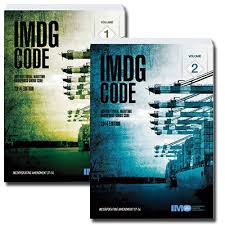Introduction to the IMDG Code
Little Pro on 2017-03-08
The International Maritime Dangerous Goods Code (IMDG Code) is an internationally agreed regulation developed by the International Maritime Organization (IMO) and sets provisions for the safe transport of dangerous goods by sea. The goal of the IMDG code is to enhance the safe transport of dangerous goods by sea and protect the marine environment. If your products are classified as dangerous goods and would like to ship them by sea, you must comply with the provisions in the IMDG code. In this article, we will give you an overview of the IMDG code.

How to Learn the IMDG Code
The provisions in the IMDG code are based on the 'UN Recommendations on the Transport of Dangerous Goods’, known as the ‘Model Regulations’, a document that provides a framework of rules for the safe transport of dangerous goods by all modes – air, road and rail as well as sea. Before you read the IMDG code, it is strongly recommended that you read the UN Model Regulations first.
The UN Model regulation has detailed the general principles of dangerous good classification,labelling, marking, placarding, documentation, and dangerous goods list. Those principles and requirements apply to all modes of dangerous goods transport (i.e., ADR, IATA).
Structure of the IMDG Code
The IMDG code consists of two books (volume 1 and volume 2), and the IMDG code supplement.
Volume 1 includes the following chapters:
- Part 1 General provisions, definitions and training
- Part 2 Classification
- Part 4 Packing and tank provisions
- Part 5 Consignment procedures
- Part 6 Provisions for the construction and testing of pressure receptacles, aerosol dispensers, small receptacles containing gas (gas cartridges) and fuel cell cartridges containing liquefied flammable gas
- Part 7 Requirements on transport operations
Volume 2 includes the following parts:
- Part 3 Dangerous goods list , special provisions for limited and excepted quantities exceptions
- Appendix A List of generic and N.O.S. (not otherwise specified) proper shipping names
- Appendix B Glossary of terms
The IMDG code supplement includes additional provisions that are relevant to sea transport. These provisions include:
- Emergency response procedures for ships carrying dangerous goods
- Medical first aid guide
- Reporting procedures
- IMO/ILO/ECE guidelines for packing cargo transport units
- Safe use of pesticides in ships, cargo holds and CTUs
- International code for the carriage of packaged irradiated nuclear fuel, plutonium and high-level radioactive wastes on board ships
How to Download the IMDG Code
The IMDG code is not free of charge. It can be ordered from IMO's website here. The latest version of the IMDG code and its supplement is listed as below.
- The IMDG Code (2016 Edition): Entry into force on 1 Jan 2018
- The IMDG Code Supplement (2014 Edition)
However, if you like free stuff, you may click here to download the IMDG code (2006 edition) in English free of charge or search here. It is good enough for learning purpose.
It should be noted that the IMDG code is updated every 2 years to be aligned with the UN Model Regulations. For example, if the dangerous good list in the UN Model Regulations is updated, the dangerous goods list in the IMDG code will also be updated.
Recommended Readings
- How to determine UN number and proper shipping name
- How to label and mark dangerous goods
- How to understand and search dangerous goods list
- How to assign UN packing group
Having Questions?
We do not provide consultancy services. If you have questions or need any help, please contact our sponsor. You may also find an expert in CSP business directory below. If you are a consultant, you may get yourself listed in CSP business directory (free) or sponsor this page to leave your contact info on this page..

Tags: Topics - TDG, Dangerous Goods